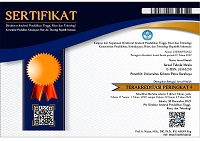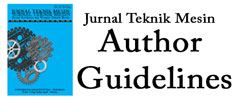Analisis Termal Macro-Thermobalance Pembakaran Serbuk Gergaji dan Campurannya
Keywords:
Sawdust, rice husk, corn cobs, macro-thermo balanceAbstract
The Sawdust is a waste of sawmill industry which can be used for energy sources. However, the existences of wastes are generally susceptible to mixed with other biomass. This research will investigated the combustion characteristics of sawdust mixed with rice husks or corncobs in powder form. Percentage weight of a mixture of rice husks or corn cobs into sawdust be varied in the range 0, 25, 50, 75, and 100%. Thermal analysis of macro-thermo balance at heating rate 20°C/min in air environment is used in this case. While the samples with weight 10g to be applied in this experiment. The results showed that the graphics TG of the sample mixture has shifted to the right for the powder size 40+/60-mesh. It means the decomposition has been delayed or occurre data higher temperature region. As for the powde rsize 20+/40- mesh graphics TG of the sample mixture shifted to the left, it means early decomposition occurred or occurs at a lower temperature. The average activation energy of carbon combustion from saw dust, saw dust-rice husk and saw dust-corncobs respectively 91.67kJ/mole, 95.28kJ/mole, and 89.83kJ/mol. While the average minimum peak of the graphics DTG, mixture of sawdust-rice husk higher and sawdust-corncobs lower than sawdust. The average reaction rate constants of carbon burning from sawdust, sawdust-rice husk and sawdust-corncobs are 0.0071, 0.0047, and 0.007, respectively.References
ESDM, Handbook of Energy & Economic Statistics of Indonesia, Jakarta, 2012.
Badan Pusat Statistik, Statistik Indonesia, Jakarta, 2012.
Surono,U.B., Peningkatan Kualitas Pem¬ba¬kar¬¬an Biomassa Limbah Tongkol Jagung sebagai Bahan Bakar Alternatif dengan Proses Kar¬boni¬sasi dan Pembriketan, Jurnal Rekayasa Proses, Vol. 4, No.1, Jurusan Teknik Mesin Fakultas Teknik Universitas Janabadra Yogya¬karta, 2010.
Suyitno, Perumusan Laju Reaksi dan Sifat-Sifat Pirolisis Lambat Sekam Padi Mengguna¬kan Metode Analisis Termogravimetri’, Jurnal Teknik Mesin UNS, Vol. 11: 12–18, 2009.
Sait, H.H., Hussain, A., Salema, A.A., Ani, F.N., Pyrolysis and combustion kinetics of date palm biomass using thermogravimetric analysis, Biore¬-sourceTechnology 118, pp.382–389, Elsevier, 2012.
Khalil, R.A. et al., Thermal analysis of energy crops Part I: The applicability of a macro-thermobalance for biomass studies, Journal Anal. Appl. Pyrolysis 81 (2008) 52–59, Elsevier, 2007.
Qiguo Yi, Fangjie Qi, Gong Cheng, Thermo-gravimetric analysis of co-combustion of bio¬mass and biochar, Journal Therm Anal Calorim, DOI 10.1007/s10973-012-2744-1, Springer, 2012.
Aries, H.D., Indarto, Saptoadi, H., dan Rohmat, T.A., Karakteristik dan Pendekatan Kinetika Global pada Pirolisis Lambat Sampah Kota Terseleksi, Reaktor, Vol. 13 No. 3, Juni 2011, hal. 140-147, UNDIP, Semarang, 2011.
Qing Wang, Hao Xu, Hongpeng Liu, Chunxia Jia, Jingru Bai, Thermogravimetric Analysis of The Combustion Characteristics of Oil Shale Semi-Coke/Biomass Blends, Oil Shale, Vol. 28, No. 2, pp. 284–295, Estonian Academy Publi¬shers, 2011.
Boris, L.V., Thermal Decomposition of Solids and Melts, Springer, 2007.
Prabir, B., Biomass Gasification and Pyrolysis Practical Design and Theory, Published by Else¬vier Inc, 2010.
Sahu, S.G., Sarkar, P., Chakraborty, N., Adak, A.K., Thermogravimetric assessment of combus¬tion characteristics of blends of a coal with different biomass chars, Fuel Processing Tech¬nology, 91 (2010) 369–378, Elsevier, 2009.
Brown, M.E., Introduction of Thermal Analysis Techniques and Applications, Chapman and Hall, USA, 1988.
Jayanti, S., Maheswaran, K. , Saravanan, V., Assessment of the effect of high ash content in pulverized coal combustion, Applied Mathema¬tical Modelling, 31 (2007) 934–953, Elsevier, 2007.
Downloads
Published
Issue
Section
License
Jurnal Teknik Mesin diterbitkan oleh Universitas Kristen Petra.
![]()
Artikel dan semua materi yang diterbitkan terkait didistribusikan di bawah Lisensi Internasional Creative Commons Attribution License (CC BY).


















